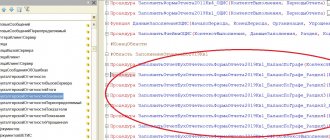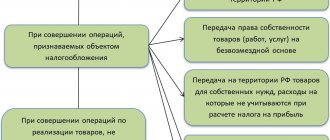Non-profit organizations are those that do not have the goal of making a profit from their activities. Their work has a social orientation. They are created to perform any cultural, religious, scientific and other tasks. In this article we will look at how accounting and tax accounting is carried out in a non-profit organization.
The activities of such associations are regulated by the chart of accounts, certain accounting regulations, as well as the following regulatory documents:
- Law on Accounting No. 402-FZ;
- Civil Code (Civil Code of the Russian Federation);
- Law “On Non-Profit Organizations” No. 7-FZ of January 12, 1996;
- Law “On Public Associations” No. 82-FZ of May 19, 1995.
Features of accounting in non-profit organizations
Non-profit organizations (NPOs) maintain accounting and prepare reports in accordance with the legislation of the Russian Federation. To maintain it, management is obliged to introduce the position of an accountant or draw up an agreement for the relevant services with another company.
Operations related to the activities prescribed in the Charter and entrepreneurship are carried out separately. Income and cost accounts are presented in the table. (click to expand)
| Activity | Check |
| Non-profit | 86 “Targeted financing” |
| Entrepreneurial major | 90 "Sales" |
| Other entrepreneurial | 91 “Other income and expenses” |
Unlike commercial companies, an NPO engaged in entrepreneurship does not have the right to distribute the income received during the period between participants. Profits must be used exclusively to fulfill the statutory goals of the association. The following entry occurs in the accounting:
Dt 90 Kt 99 - reflects the profit received at the end of the reporting period.
At the end of the year 99 close:
Dt 99 Kt 84 - net profit for the year is taken into account;
Dt 84 Kt 86 - financing of statutory work.
If the commercial activities of the NPO resulted in losses, make the following entries:
Dt 99 Kt 90 - loss for the period (month) is taken into account;
Dt 84 Kt 99 - annual loss is reflected.
The loss is covered from certain sources. For example, from the reserve fund, from last year’s profit, additional investments of participants, etc.
The following entries take place:
Dt 76 Kt 84 - the loss is repaid through membership fees;
Dt 86 Kt 84 - due to last year’s profit;
Dt 82 Kt 84 - from the reserve fund.
Example No. 1. Write-off of business results
NPO "Barrier" provides services for a fee. For 2021, income amounted to 614 thousand rubles, expenses - 389 thousand rubles.
Postings are made throughout the year:
Dt 62 Kt 90,614,000 - revenue from business is taken into account;
Dt 90 Kt 20,389,000 - the cost of services has been written off;
Dt 90 Kt 99,225,000 - the result of the association’s work is taken into account.
At the end of the year, the accountant will write:
Dt 99 Kt 84,225,000 - profit written off;
Dt 84 Kt 86,225,000 - annual profit added to target amounts.
An NPO can take property into account as fixed assets if the following conditions are met:
- Application in the work established by the Charter, for the needs of management or entrepreneurship;
- Application for a period exceeding one year;
- Donation or transfer of ownership to other persons is not provided for.
The object is assessed at market value at the time of registration. The cost of fixed assets is reflected by the entry: Dt 08 Kt 86.
For fixed assets, NPOs charge depreciation instead of depreciation, like commercial companies. The data obtained is used when calculating property tax based on the annual average value of fixed assets (Article 375 of the Tax Code of the Russian Federation).
The amount of depreciation is shown on the off-balance sheet account, and fixed assets are shown on the balance sheet at their original cost. Otherwise, the asset will not be equal to the liability. A feature of the accounting of fixed assets received from earmarked funds is the use of accounts. 83. In the balance sheet, its balances are reflected in the line “Real estate and movable property fund”.
Accounting for non-profit organizations that engage only in non-commercial activities
The main difference from commercial organizations is that account 90 “Revenue” is not used.
All income and expenses are reflected using account 86 “Targeted financing”.
There are two accounting options available here:
- Receipts of money, materials, fixed assets, etc. immediately attributed to 86:
DT 51 (50, 10, 08...) – KT 86
- Use additional posting with account 76 “Settlements with various debtors and creditors”:
DT 76 – CT 86 – amount receivable accrued
DT 51 (50, 10, 08) – CT 76 – money or property received
The first option is convenient to use if the NPO receives a lot of “small” donations from individuals. If funds come from organizations or government agencies, then it is better to use account 76. Then it will be possible to control the status of settlements with each counterparty.
Cost accounting for the main activities and management of the organization is carried out using accounts 20 and 26, similar to commercial companies. The difference is that in the end, cost accounting accounts are closed not on account 90, but on account 86.
DT 20 (26) – CT 10, 60, 69, 70... costs associated with the main activities and management of non-profit organizations are taken into account
DT 86 – CT 20 (26) – costs written off due to targeted financing
If, at the expense of targeted proceeds, a fixed asset was purchased (built), then the costs for it should be charged to account 83 “Additional capital”.
DT 08 – KT 60 – fixed assets purchased, and input VAT must be included in the initial cost
DT 01 – KT 08 – OS put into operation
DT 86 – KT 83 – additional capital increased due to targeted financing
Among the cost accounts given above, there are no 02 and 04, reflecting depreciation. This is no coincidence.
Depreciation on fixed assets of non-profit organizations is not charged. Instead, depreciation must be reflected in off-balance sheet account 010 using the linear method (clause 17 of PBU 6/01). If an NPO has intangible assets, then neither depreciation nor depreciation is charged on them (clause 24 of PBU 14/2007).
If an NPO sells a fixed asset, then account 91 “Other income and expenses” should be used.
DT 76 – CT 91 – sales revenue
DT 91 – KT 68.2 – VAT is charged on the difference between the sales and book value of fixed assets (clause 3 of Article 154 of the Tax Code of the Russian Federation).
DT 83 – KT 01 – the cost of the sold asset was written off
NPOs that conduct only non-commercial activities must annually submit a balance sheet and a report on the intended use of funds by March 30 (Clause 2 of Article 14 of Law No. 402-FZ).
Simplified taxation in non-profit organizations
NPOs have the right to apply simplified taxation. They can choose the simplified tax system upon creation by submitting a corresponding application to the tax office, or switch to the regime during the management process. Restrictions on the use of the simplified tax system are presented in the table.
| Index | Limitation |
| State | No more than 100 people |
| Income for 9 months | Not higher than 45 million rubles. |
| Residual value of funds | Less than 100 million rubles |
| Branches | None |
| NPO is not a manufacturer of excisable products | |
Organizations on the simplified tax system submit a single simplified declaration to the inspectorate every year. They are exempt from paying income taxes, property taxes and VAT. NPOs use a simplified method to calculate the single tax. When taxed “by income”, it is equal to 6% of all income received. With the object “income minus expenses” - 15% of the difference, and if there is no difference - 1%. (see → NPO taxation, rates in 2021)
Revenues used for statutory purposes are not subject to a single tax. This applies to grants, membership fees, donations, and subsidies for targeted needs. Simplified NPOs are required to account for income and expenses of available target amounts separately.
Under this system, the manager has the right to perform the duties of the chief accountant and not resort to the services of other organizations for accounting. The transition to the simplified tax system is beneficial for non-profit organizations engaged in the sale of goods, work for a fee and having taxable property on their balance sheet.
Target income for NPOs
From January 1, 2011, the list of income not taken into account by non-profit organizations for profit tax purposes has been expanded.
The corresponding amendments were made by Federal Law No. 235-FZ of July 18, 2011 “On amendments to part two of the Tax Code of the Russian Federation in terms of improving the taxation of non-profit organizations and charitable activities.”
The following are not taken into account when determining the tax base for income tax:
- targeted revenues for the maintenance of non-profit organizations and the conduct of statutory activities,
- grants for the implementation of programs in the field of science, physical education and sports (with the exception of professional sports);
- founding and membership fees made in accordance with the legislation of the Russian Federation on non-profit organizations;
- income received free of charge by non-profit organizations in the form of work (services) performed (rendered) on the basis of relevant contracts (subclause 1, clause 2, article 251 of the Tax Code of the Russian Federation);
- property rights transferred to non-profit organizations by will in the order of inheritance (subclause 2, clause 2, article 251 of the Tax Code of the Russian Federation, previously only property was exempt);
- property rights received for the implementation of charitable activities (subclause 4, clause 2, article 251 of the Tax Code of the Russian Federation, previously only property was exempt);
- funds received by non-profit organizations free of charge for the conduct of statutory activities not related to business, from those transferred by structural divisions (departments) from targeted revenues (subclause 10.1, clause 2, article 251 of the Tax Code of the Russian Federation);
- funds received by structural units (departments) from the non-profit organizations that created them, transferred from targeted revenues for the maintenance and conduct of statutory activities (subclause 10.1, clause 2, article 251 of the Tax Code of the Russian Federation).
It is important
Non-profit organizations can also carry out entrepreneurial activities if this corresponds to the purposes for which they were created.
Reporting of non-profit organizations
The composition of the reporting forms differs depending on the types of activities of the NPO. The differences are shown in the table.
| Activity | Reports | Frequency of delivery |
| a commercial | balance sheet how to fill out form 1; profit and loss how to fill out form 2; changes in capital (form 3); movement of money (f. 4); how to fill out form 4 appendix to the balance sheet (form 5); intended use of funds (form 6); explanatory note. | Quarterly |
| Non-profit | Forms No. 1, 2, 6. | Once a year |
In addition to accounting, NPOs submit tax returns for the following:
- VAT;
- property tax;
- income tax;
- land tax;
- transport tax.
Property tax is calculated based on its value according to the cadastre (Article 346.11 of the Tax Code of the Russian Federation). NPOs provide data on the average number of staff and 2-NDFL certificates. NPOs submit Form 4-FSS quarterly to the social insurance fund, and RSV-1 calculations to the pension fund. Read also the article: → “Calculation using the RSV-1 form (reporting for employees to the Pension Fund of Russia).” Form 1-NKO is submitted to the statistical office. It contains data about the work of the organization. Short Form No. 11 is submitted annually and includes data on the availability and movement of fixed assets.
Three forms are submitted to the Ministry of Justice:
- OH0001 - data on the management and nature of the activities of the NPO;
- OH0002 - expenditure of targeted funds and use of assets;
- OH0003 - filled out on the website of the Ministry of Justice.
Information on the personnel of the governing bodies of a non-profit organization (Form No. ON 0001)
Report on the expenditure of funds by a non-profit organization and on the use of other property, including those received from international and foreign organizations, foreign citizens and stateless persons (Form No. ON 0002)
Report on the volume of funds and other property received by a public association from international and foreign organizations of foreign citizens and stateless persons on the purposes of their expenditure or use and on their actual expenditure or use (Form No. ON 0003)
These forms are submitted only by those organizations whose annual receipts exceed 3 million rubles, there are receipts from foreign individuals and companies, or if there are foreigners among the NPO participants.
Accounting for funds in accounts
To record, store, and use cash, NPOs must use a cash register. The cash balance limit is mandatory and is pre-agreed with the credit institution providing services to the entity.
Cash transactions are carried out using cash registers if the organization is engaged in trade or provides services. To accept contributions, donations, and other receipts from individuals, cash register equipment is not needed. Cash transactions are completed using standardized document forms.
NPO participants deposit money into the cash register or into the organization’s account. This procedure must be determined by the head or the Charter of the association.
Receipt of contributions from members of the association is formalized as follows: Dt 50 (51, 52, 55), Kt 86 - the receipt of target funds to the cash desk (account) is reflected. The cash register inventory is carried out in accordance with the legislation of the Russian Federation.
Accounting for intangible assets
Intangible assets (IMA) are accounted for in non-profit organizations on the basis of PBU 14/2007. When accepting them for accounting, the period of planned use for solving the statutory tasks of the organization is established. This period is subject to annual review and clarification. If there are adjustments, they are reflected in accounting and reporting forms at the beginning of the year as changes in estimates.
Depreciation on intangible assets is not accrued in non-commercial organizations, even when they are used in commercial activities (clause 24 of PBU 14/2007). If intangible assets are acquired using business income, then depreciation is allowed.
For example, if you create your own computer program, the postings will be as follows:
Dt 08.5 KT 10, 70, 69 - the costs of creating the product are taken into account;
Dt 04 Kt 08.5 - the program is registered as an intangible asset;
Dt 86 Kt 83 - target amounts were used to create intangible assets.
Use of targeted funds
The use of targeted funds is carried out strictly in accordance with the NPO's estimate for financing the costs of its maintenance and implementation of its statutory activities.
Example 4 - buying a car
On October 15, 2014, the NPO, according to the approved estimate, partially allocated targeted funds for the purchase of a car in the amount of 600,000 rubles. for management purposes of the organization. The following entries were made in the accounting department of the NPO:
| date | Account Dt | Kt account | Sum | Contents of operation | Document |
| 15.10.2014 | 60 | 600000 | The invoice issued by the seller has been paid | Invoice | |
| 15.10.2014 | 08 | 60 | 600000 | Car arrival | Invoice |
| 15.10.2014 | 01 | 08 | 600000 | The car was accepted for accounting as part of the fixed assets of the non-profit organization | Agreement |
| 15.10.2014 | 86 | 83 | 600000 | Using targeted funds to purchase a car | Accounting information |
Example 5 - helping an orphanage
NGOs were allocated funds to provide free assistance to the orphanage. Using these funds, on October 15, 2014, the NPO purchased children's clothing in the amount of 250,000 rubles, and also paid for work related to the overhaul of the orphanage building in the amount of 1,500,000 rubles. These transactions were reflected as follows:
| date | Account Dt | Kt account | Sum | Contents of operation | Document |
| 15.10.2014 | 60 | 250000 | The seller's invoice for children's clothing has been paid. | Invoice | |
| 15.10.2014 | 10 | 60 | 250000 | Received children's clothing is accepted for accounting | Accounting information |
| 15.10.2014 | 86 | 10 | 250000 | Donation of children's clothing to an orphanage | Agreement |
| 15.10.2014 | 60 | 1500000 | Payment for building repairs | Agreement, invoice | |
| 15.10.2014 | 86 | 60 | 1500000 | Writing off the amount of repairs from targeted funds | Accounting information |
Example 6 - paid services of NPOs
In this example, we will consider how the financial result of the commercial activities of an NPO is written off.
Let’s say an NPO provides paid services, the income for which in 2014 amounted to 600,000 rubles. At the same time, the costs of carrying out this type of activity amount to 400,000 rubles.
During 2014, the following postings will be made to the non-profit organization:
| date | Account Dt | Kt account | Sum | Contents of operation | Document |
| 62 | 90/"Revenue" | 600000 | Revenue from the provision of paid services is reflected | Accounting information | |
| 90/"Cost of sales" | 20 | 400000 | The cost of services provided is written off | Accounting information | |
| 90/"Profit/loss from sales" | 99 | 200000 | The financial result from the provision of services is reflected | Accounting information | |
| 31.12.2014 | 99 | 84 | 200000 | Write-off of net profit of the reporting year | Accounting information |
| 31.12.2014 | 84 | 86 | 200000 | Inclusion of net profit of the reporting year in target financing | Accounting information |
Postings and decoding of operations
Account 86 is used in the following main business transactions.
| Debit | Credit | Explanation of the operation |
| 86 | 20, 26 | Target amounts spent |
| 83 | Amounts spent are included in additional capital | |
| 98 | Target amounts added to future expenses | |
| 07 | 86 | Equipment for statutory events taken into account |
| 08 | Contribution to non-current assets reflected | |
| 10, 11 | Materials (animals) were capitalized as a target receipt | |
| 15 | Inventory taken into account for events according to the Charter | |
| 20 | The main production facility was received | |
| 41 | Goods transferred for targeted programs are taken into account | |
| 76 | Financing accrued |






